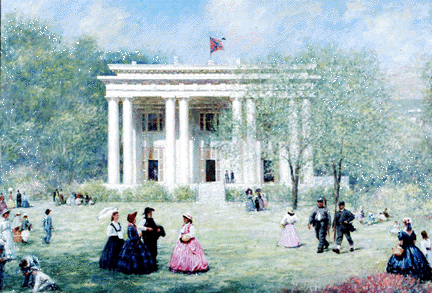![]()
![]()

|
Soon after his inauguration as provisional president on February 18, 1861, Davis appointed his first cabinet; each of the six members represented a different state. The first task of the administration was to prepare for the impending conflict. Between December 30, 1860, and February 18, 1861, the Confederates had seized 11 federal forts and arsenals from South Carolina to Texas and harassed Fort Sumter in Charleston, South Carolina. Lincoln, in his inaugural address on March 4, 1861, rejected the right of secession but attempted to conciliate the South. Negotiations for the relief of Fort Sumter failed, and on April 12 the bombardment of the fort began. Three days later Lincoln announced that an insurrection had occurred, and he called for volunteers. The number of states in the Confederacy was increased to 11 by the secession of Virginia in April and of Arkansas, Tennessee, and North Carolina in May. The provisional Confederate Congress, which had met for four sessions between February 4, 1861 and February 17, 1862, was replaced by a permanent legislature on February 18, 1862. The Confederate capital was moved on May 24, 1861 from Montgomery to Richmond, Virginia. At the first general elections held under the permanent constitution on November 6, 1861, Davis was elected president and Stephens vice president. In February 1862, Davis was inaugurated president for a term of 6 years. The last years of his service were marked by the conflict between the civil and military forces and gave rise to the assertion that the government of the Confederacy had become a military dictatorship. The tendency toward dictatorship was increased by the custom of holding secret sessions of the Congress, by the practice of cabinet officers exercising their rights to sit in Congress, and by the gradual lowering of the political morale and independence of Congress. This condition was further complicated by personal controversies among officials. The first permanent Congress held four sessions; the second Congress, two sessions, with the final adjournment of the body taking place on March 18, 1865. Although the political organization of the Confederacy was almost identical with that of the Union, the outbreak of the war served to accentuate the marked difference between the two sections. The population of the Confederacy at the start of the war was nearly 9 million including more than 3.8 million slaves. The population of the territory loyal to the Union was about 22 million, including about 500,000 slaves. The value of the improved lands of the seceding states was estimated at less than $2 billion; the value of those in the Union states was nearly $5 billion. The South had 150 textile factories, with a product valued at $8 million; the North had 900 such factories, with a product valued at $115 million. In the South 2000 persons were employed in the manufacture of clothing; in the North 100,000 were so engaged. During 1860 the imports of the South were valued at $331 million; those of the North at $31 million. It was thus obvious that the South was dependent on Europe and on the North for material goods. The lack of resources forced the Confederacy to levy war taxes and borrow heavily on future cotton crops. An inflationary period in 1863 and later government actions almost destroyed the Confederate credit. In addition the South was hampered by the lack of powder mills and of suitable iron works; only one plant, the Tredegar Iron Works in Richmond, was equipped to turn out large field guns. The railroad system was inadequately developed and equipped, and although the South made desperate attempts to maintain itself in a battle against overwhelming odds, the struggles left it financially and industrially ruined at the close of the Civil War. The process of restoring the Confederacy to the Union was called Reconstruction. |
Bibliography: Commager, Henry S., Defeat of the Confederacy, A Documentary Survey (1964); Coulter, E. Merton, Confederate States of America (1950); Davis, Jefferson, The Rise and Fall of the Confederate Government, abr. ed. (1961); Eaton, Clement, History of the Southern Confederacy (1954; repr. 1966); Faust, Drew, The Creation of Confederate Nationalism (1988); Owsley, Frank L. and H. C., King Cotton Diplomacy, 2d ed. (1959); Roland, Charles P., The Confederacy (1960); Vandiver, Frank E., Their Tattered Flags: The Epic of the Confederacy (1970; repr. 1987); Wiley, Bell I., and Milhollen, Hirst D., Embattled Confederates: An Illustrated History of Southerners at War (1964).